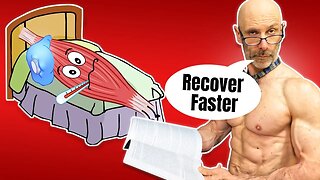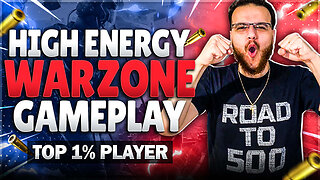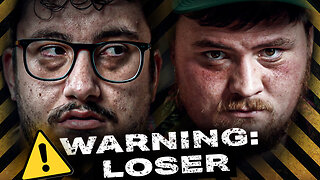Premium Only Content

Is Delayed Onset Muscle Soreness Good For Muscle Growth
Is delayed onset muscle soreness good for muscle growth
Delayed onset muscle soreness, or DOMS what causes it? What does it tell us about our training? Is it a sign that we are building muscle or that we have new muscle growth?
When we workout often times we will feel sore right after. Now this is not DOMS. This is what they call acute muscle soreness. It is caused by a lactic acid build up in our muscles usually accompanied by swelling which we like to call the pump and many of us love that feeling. There is usually some stiffness that comes along with it, this is related to the swelling.
If you are interested in losing body fat and adding muscle, please email me at 1shark1bite@gmail.com for information on my personal training services.
Facebook; https://www.facebook.com/Fit-and-50-548844435514900/
My Amazon page link; https://www.amazon.com/shop/fitand50
My Affiliate link to Lebert for their Equalizer bars and more; http://www.easywebautomation.com/app/?af=1679568 and use the discount code LFI20 you will receive 20 dollars off your purchase
Lactic acid build up is part of metabolic stress one of the 3 mechanisms we use to build muscle.
Delayed onset muscle soreness is different. This type of soreness doesn’t usually start to kick in until 12 to 24 hours after are workout and tends to peak in 1 to 3 days, then it starts to subside. There was a time when it was thought this soreness too, was the result of lactic acid, but it is now clear that this isn’t the reason. As any lactic acid build up clears out within a few hours after training.
They don’t really know what causes DOMs, but there are certain movements that tend to bring It about more than others. These involve stretching, for example the negative portion of the movement or the eccentric and especially if you stretch the muscle in the eccentric position like you would with Romanian Deadlifts, chest flys, or incline curls.
The theory is that the negative portion of the movement creates more muscle damage which causes the swelling and soreness. Recovering from muscle damage is another way we build muscle. So, you can start to see how some might equate muscle soreness to muscle growth.
Now muscle soreness in general isn’t that uncommon and I’m of the opinion that if you never feel anything after your workout your probably not training hard enough. Delayed onset muscle soreness is a little different. People who tend to suffer from DOMs tend to be newer lifters, especially if they throw themselves into a new training program going 110% without taking the time to get used to the movements.
The other group includes experienced lifters when they first start to incorporate new exercises that they haven’t done before in their training. It can take several months for the body to adapt to these changes in training and lifestyle.
Despite the theory’s about what cause’s delayed onset muscle soreness there doesn’t seem to be a direct connection between DOMs and muscle growth with some muscles rarely getting sore yet still growing. People who train less frequently also tend to suffer more from DOMs. Which contradicts what we know about the connection between higher frequency and volume of training to muscle growth.
If you have trouble with muscle soreness a couple of simple things you can do to help lessen the effects of it preworkout is to make sure your well hydrated and do a good warm up before your workout. According to a 2013 study applying heat right after exercising and in particular moist heat either through damp towels or a warm bath reduced the discomfort of delayed onset muscle soreness. I bring this up because the more common treatment is to apply cold with many athletes jumping into an ice bath to try and reduce the exact same effects. There is logic to both as heat encourages blood flow which promotes healing and cold reduces inflammation. So you might want to experiment with both to see what works best for you.
A massage will help provide relief too. This can be accomplished with a foam roller. I found a study that showed watermelon can help because it contains L-citrulline and studies have suggested this amino acid reduces muscle soreness.
It is important to keep moving as this will encourage blood flow into the affected area promoting healing. If you are still significantly sore by your next workout. Then make sure you avoid working the affected area or possibly just do a light mobility workout or some yoga. This way we can keep working out while having fun
https://www.ncbi.nlm.nih.gov/pmc/articles/PMC3808259/
https://pubs.acs.org/doi/abs/10.1021/jf400964r
https://www.acsm.org/docs/default-source/files-for-resource-library/delayed-onset-muscle-soreness-(doms).pdf?sfvrsn=8f430e18_2
-
 4:53
4:53
Fit and 50
1 year ago $0.07 earnedHow to Speed Up Muscle Recovery Over 50 (Recover Like a 20 yr old)
5844 -
 LIVE
LIVE
LFA TV
5 hours agoLFA TV ALL DAY STREAM - WEDNESDAY 8/27/25
5,599 watching -
 LIVE
LIVE
GloryJean
2 hours agoAggressive Solo Gameplay on Mouse & Keyboard 🖱️ 6.7 K/D
67 watching -
 LIVE
LIVE
The Pascal Show
1 hour ago $0.11 earnedBREAKING! Mass Shooting At Annunciation Church In Minneapolis Multiple Shot
89 watching -
 1:43:04
1:43:04
Dear America
3 hours agoNo More IRS!! Tariffs Bring In Over $500 BILLION! + Taylor Swift Got ENGAGED… This Is A Nightmare!!
91K77 -
 LIVE
LIVE
Caleb Hammer
19 hours agoHe Just Sucks… | Financial Audit
76 watching -
 LIVE
LIVE
MYLUNCHBREAK CHANNEL PAGE
2 hours agoThe Population Was ZERO
597 watching -
 LIVE
LIVE
Wendy Bell Radio
7 hours agoTrump Cracks The Barrel
7,002 watching -
 LIVE
LIVE
The Big Mig™
3 hours ago2020 Election Fraud Burn Bags Discovered
5,112 watching -
 LIVE
LIVE
Law&Crime
2 hours ago $0.54 earnedLIVE: Adelson Matriarch Murder Trial — FL v. Donna Adelson — Day 4
113 watching